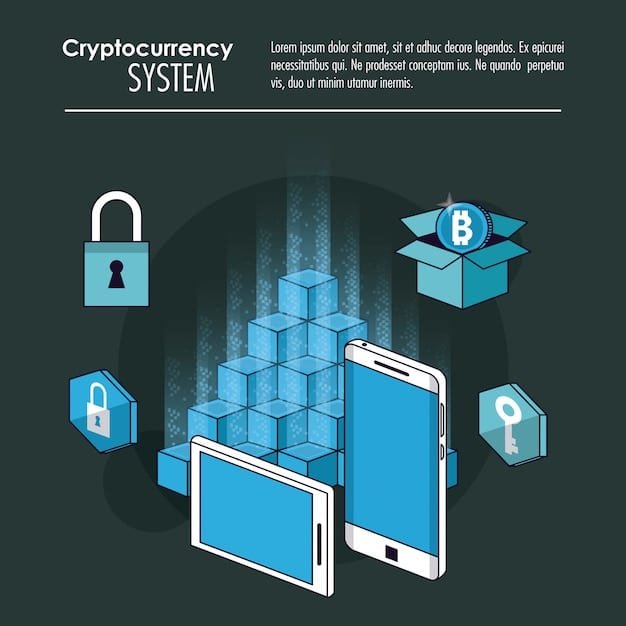Quantum Computing and Credit Card Security: Preparing for Future Threats in the US

Credit card security faces a potential paradigm shift with the advent of quantum computing, as current encryption methods may become vulnerable to quantum attacks, necessitating proactive measures within the US financial sector.
The landscape of credit card security in the age of quantum computing: preparing for future threats in the US financial sector is rapidly evolving, requiring a proactive approach to safeguard sensitive financial data against potential quantum attacks.
Understanding the Quantum Computing Threat to Credit Card Security
Quantum computing is no longer a distant theoretical possibility; it’s an emerging reality with the potential to disrupt many sectors, including finance. Its ability to break current encryption standards poses a significant threat to credit card security.
The main concern lies in the fact that quantum computers can execute certain calculations far faster than classical computers. This capability directly undermines the cryptographic algorithms that currently protect credit card data.
How Quantum Computers Decrypt Data
The cryptography used in credit card transactions today relies on mathematical problems that are difficult for classical computers to solve. Quantum computers, however, can solve these problems relatively easily using algorithms like Shor’s algorithm.
- Shor’s algorithm can efficiently factor large numbers, which is the basis of RSA encryption, a common method for securing online transactions.
- Grover’s algorithm can speed up the process of searching unsorted databases, potentially compromising key management systems.
- This means sensitive information such as credit card numbers, expiration dates, and CVV codes could be at risk.
The industry needs to understand these vulnerabilities to defend credit card security in the face of quantum computing advancements.
Current Encryption Standards and Their Vulnerabilities
Existing security protocols like RSA, ECC, and AES are fundamental to protecting credit card data. However, they are susceptible to quantum attacks.
Understanding the limitations of these standards helps organizations prepare for the transition to quantum-resistant cryptography.
RSA, ECC, and AES: The Basics
These encryption methods form the backbone of credit card security. RSA and ECC are used for public-key cryptography, while AES is a symmetric encryption algorithm for data protection.
- RSA’s security depends on the difficulty of factoring large numbers into their prime factors.
- ECC’s strength comes from the complexity of solving the elliptic curve discrete logarithm problem.
- AES is a block cipher considered secure against classical computing attacks but vulnerable to quantum attacks via Grover’s algorithm.
The critical issue is that quantum computers can efficiently break these mathematical problems, rendering current encryption methods ineffective.

Post-Quantum Cryptography: The New Defense
Post-quantum cryptography (PQC) refers to cryptographic algorithms that are believed to be secure against both classical and quantum computers. The exploration and implementation of PQC are vital for ensuring future credit card security.
There are several types of cryptographic algorithms considered suitable for post-quantum use. Research and development in this field are ongoing to identify the most promising candidates.
Types of Post-Quantum Algorithms
NIST (National Institute of Standards and Technology) has been evaluating and standardizing PQC algorithms. These algorithms fall into several categories:
- Lattice-based cryptography uses the difficulty of solving mathematical problems on lattices.
- Code-based cryptography relies on the challenges of decoding general linear codes.
- Multivariate cryptography is based on the difficulty of solving systems of multivariate polynomial equations.
Migrating to PQC is not a simple task, and it requires careful planning and execution to minimize disruption.
These new defenses play a vital role in maintaining credit card security against quantum threats, necessitating a focus on integrating them into financial systems.
Preparing the US Financial Sector: A Strategic Approach
Transitioning the US financial sector to quantum-resistant cryptography requires a coordinated and strategic approach. This involves assessing risks, updating infrastructure, and training personnel.
A proactive approach includes identifying critical systems needing upgrades and establishing timelines for implementing PQC.
Steps for a Smooth Transition
Financial institutions must undertake a comprehensive risk assessment to identify which systems and data are most vulnerable to quantum attacks.
- Conduct an inventory of cryptographic assets and prioritize systems for upgrade based on risk.
- Develop migration strategies that minimize disruption to existing operations.
- Ensure staff are trained in the principles and practices of post-quantum cryptography.
Collaboration between financial institutions, technology providers, and government agencies is essential to ensure a smooth transition.

Challenges and Considerations in Implementation
Implementing post-quantum cryptography presents several challenges. These include the performance impact of new algorithms, the need for new hardware, and the integration with legacy systems.
Understanding how these challenges can be overcome is crucial for successful PQC deployment.
Addressing the Hurdles
One of the main challenges is the computational overhead of PQC algorithms, which can be more resource-intensive than current encryption standards.
To overcome these challenges:
- Optimize algorithms and hardware implementations to improve performance.
- Develop hybrid approaches that combine classical and post-quantum cryptography for a layered security model.
- Engage with industry partners to ensure seamless compatibility with legacy systems.
A comprehensive approach is necessary to effectively address the hurdles associated with implementing these advanced security measures.
The Role of Government and Industry Standards
Government agencies and industry standards bodies play a crucial role in promoting the adoption of post-quantum cryptography within the financial sector. Standards provide guidelines and benchmarks for security practices.
NIST’s standardization efforts are important for ensuring interoperability and security across the industry.
Standardization and Compliance
NIST’s PQC standardization project is expected to provide clear guidelines for selecting and implementing quantum-resistant algorithms.
Compliance with these standards may become a regulatory requirement for financial institutions to demonstrate due diligence in protecting sensitive data.
- Following NIST’s guidelines will help organizations ensure they are using vetted and reliable cryptographic solutions.
- Industry standards such as PCI DSS may also incorporate post-quantum cryptography requirements in the future.
- Staying informed about evolving standards will be crucial for maintaining robust security.
Adherence to standardization and compliance measures is essential for the widespread integration of post-quantum cryptography, ensuring secure practices across the financial sector.
| Key Point | Brief Description |
|---|---|
| 🔑 Quantum Threat | Quantum computers can break current encryption. |
| 🛡️ Post-Quantum Cryptography | New algorithms resistant to quantum attacks. |
| 🏛️ Standards & Compliance | Government plays role in PQC adoption. |
| 🔄 Transition Strategy | Requires risk assessment and infrastructure updates. |
Frequently Asked Questions
▼
▼
▼
▼
▼
Conclusion
Addressing the quantum computing threat to credit card security is an ongoing process that requires proactive planning, strategic investment, and ongoing adaptation. By staying informed, adopting post-quantum cryptographic solutions, and collaborating with industry and government, the US financial sector can safeguard credit card security against future threats. The transition to quantum-resistant cryptography is a critical step in ensuring the continued trust and security of digital financial transactions.





